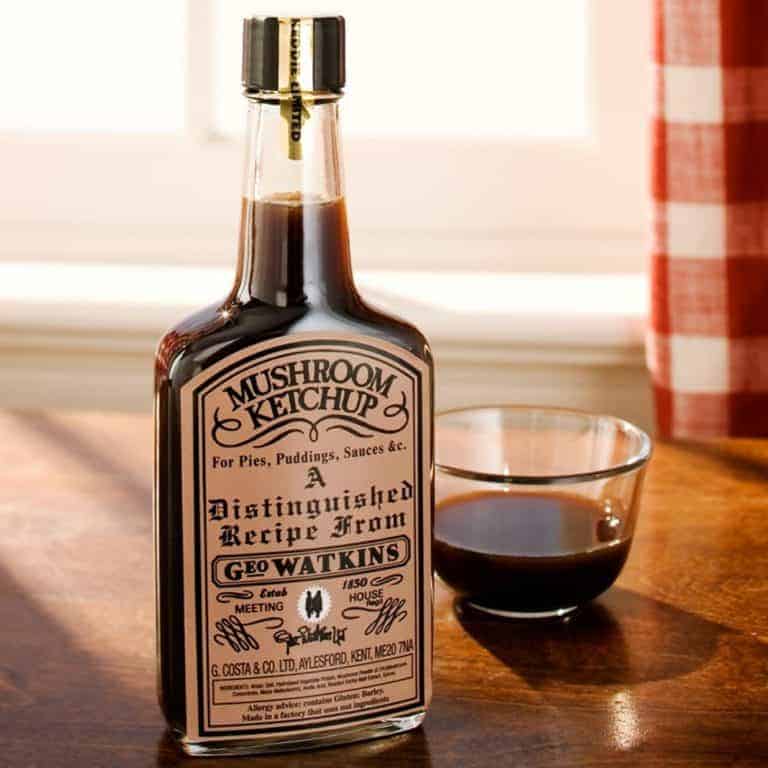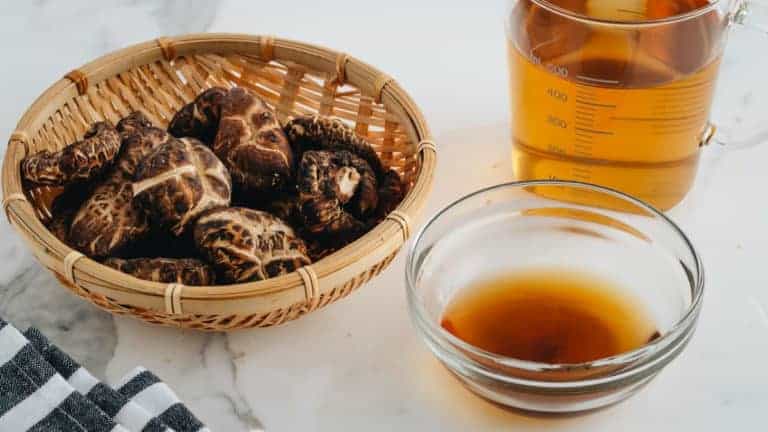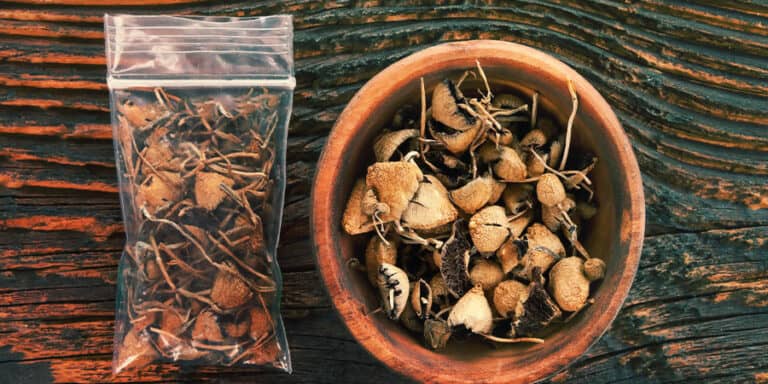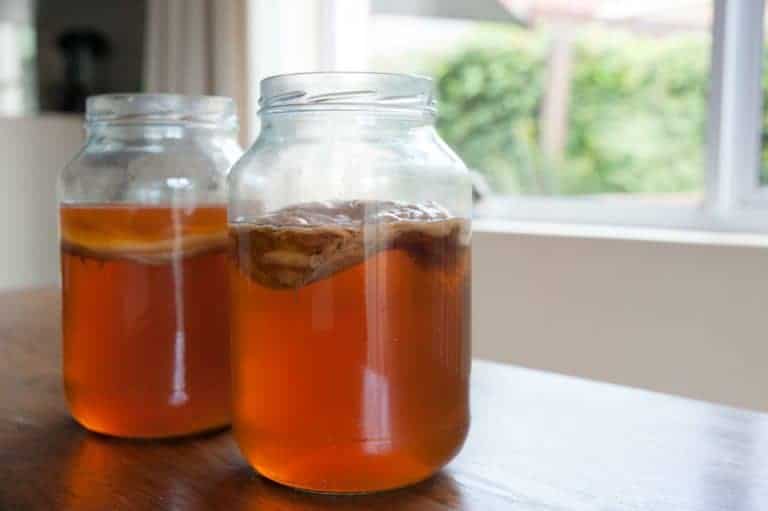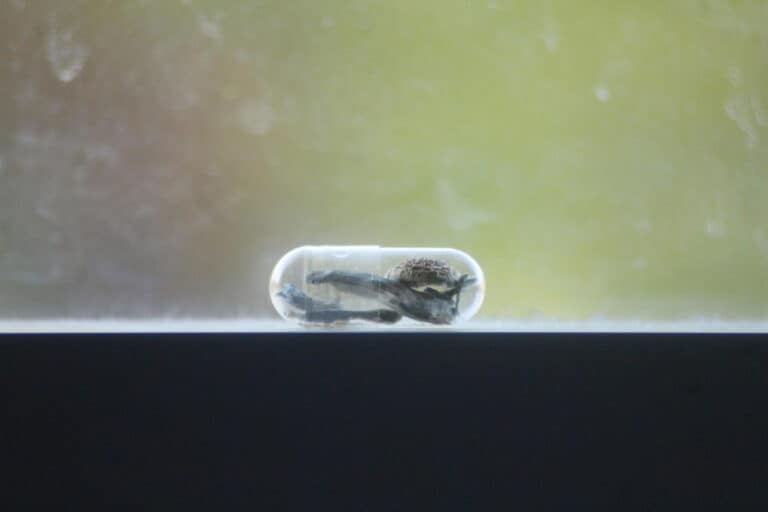All About the SCOBY and How to Use it After Your Kombucha Brew

When I brewed my first batch of Kombucha, I remember being perplexed the moment I saw that slimy, beige blob that could easily be mistaken for some sort of alien lifeform.
Kombucha tea has been nicknamed “Mushroom Tea” because of the mushroom-shaped blob of yeast and bacteria that floats to the top of the batch and brings on the fermentation process.
The blob is most commonly referred to as a SCOBY, an acronym for “symbiotic colony of yeast and bacteria”. The SCOBY goes by many other names, including mother, mushroom (partly inaccurate because it is yeast and bacteria), and the more technical ones, a pellicle or biofilm. In any case, it is a thick, slimy, and fibrous mass and apart from being crucial to making your own Kombucha at home, it has many other interesting and creative uses.
What Exactly is a SCOBY?
The pancake-like structure of the SCOBY is made up of mostly cellulose weaved together by the bacteria present in the colony. Cellulose is an insoluble fiber and the same thing that trees and other plants use to build up biomass.
The biofilm contains several species of yeast and bacteria. The SCOBY is added to sweetened black or green tea and then the brew ferments anywhere from one to four weeks. The yeast uses the sugar that’s added to produce the alcohol (the same process used in making beer and wine) and the bacteria convert the alcohol to acetic acid. In this way, the yeast provides the food and the bacteria provide the living quarters.
The bacteria require oxygen to grow and make their byproducts. There is less oxygen available near the bottom of the Kombucha jar, so the bacteria like to create a biofilm at the top surface to be close to the oxygen.
Yes, the SCOBY is Edible!
While it may not be the first thing that comes to mind when you see a SCOBY, they are perfectly edible and have many great health benefits. The SCOBY is a low-carb, probiotic-rich treat with lots of insoluble fiber from the high cellulose content.
There are many creative options when choosing to cook with some extra SCOBYs. They can be thrown into a smoothie, adding a nice boost of beneficial bacteria and a kick of tartness.
Popularly known as “vegan calamari”, SCOBYs can also be included in stir-fries after dicing them or included in soups such as miso as dumplings.
Another great option is dehydrating them to make SCOBY jerky. All you have to do is cut them into strips, marinate them in your favorite sauce and dehydrate them (using either an oven or a dehydrator) until they reach jerky consistency. The jerky can be stored in a dry, sealed container for months and makes for a great dog treat as well. Many pet owners report that regular SCOBY snacks improve their dog’s digestion, coat health, and skin conditions such as mange due to the vitamins, minerals, fiber, and probiotic content.
Other creative SCOBY food choices include SCOBY sushi (replacing raw fish), SCOBY fruit rollups, or dessert options such as SCOBY candy, popsicles, or sorbet. To truly maximize the dose quantity of the probiotics, you can also snack on some raw SCOBY, which has a similar texture to raw squid. To minimize toughness and a potentially leathery texture, choose to eat or cook with young, fresh SCOBYs.
The SCOBY is Great for Skin Health
The SCOBY is a great DIY option in your skin care regimen. Many people with dry, aging, or sensitive skin report significant benefits from fermented ingredients due to their high probiotic content and acidity. Due to the low pH of the culture (between 2.5-3.2 usually), it acts like a mild all-natural acid peel which helps to disinfect and exfoliate the skin, leaving it glowing and feeling smooth.
While some use the kombucha tea as a natural cleanser, the SCOBY can be used directly as a face mask. All you have to do is take the pancake out of the brew jar and leave it on the face for five to ten minutes. These face mask SCOBYs can be reused four to six times when stored properly in a SCOBY hotel reserved for skincare.
Alternatively, freshly trimmed pieces of SCOBY can be thrown in a blender and made into a SCOBY face cream. Being the mother culture of all the yeast and bacteria, the SCOBY is packed full of beneficial compounds that leave the skin feeling bright and vitalized.
Due to the probiotics and organic acids present in the SCOBY, it has significant antimicrobial properties. Recent studies have shown that it can be used to treat skin conditions such as acne and rosacea.
As an added bonus, since the good bacteria grow and prevent the growth of harmful bacteria in a controlled and sterile environment, fermented skincare products like this one don’t require the preservatives found in other beauty products that some skin types may be sensitive to.
Can a SCOBY Go Bad?
Absolutely, and If any hint of contamination is spotted, immediately discard the SCOBY/brew and restart. An unhealthy SCOBY will have an unpleasant smell, may show signs of decay, or may have mold on it. Mold may grow if the brew is too cold or under-acidified. It might show up as white, dry fuzzy patches on the surface, bluish gray circles, or as a powdery tan coating on top of the SCOBY. If you see something odd near the bottom of the jar, it’s likely that it is strands of yeast rather than mold.
Good tea or starter liquid should smell fresh, tart, and a little vinegary (which increases as the fermentation process continues). If the liquid smells rancid or off-putting, it is better to not risk it and start over.
To prevent molding, keep the pH anywhere below 3.5, and store any SCOBYs in at least two cups of starter liquid to prevent it from dehydrating and becoming a good mold medium. Too cold of temperatures will also prevent the survival of the good bacteria and yeast, so be sure to never freeze or refrigerate the SCOBY.

Image source
A healthy SCOBY will appear anywhere from almost white, to beige, tan, or some shade in between. A healthy SCOBY will range from a quarter inch to half an inch thick. Less than a quarter inch thick and the culture may be too weak to brew a successful batch, and more than half an inch may prevent the culture from receiving adequate oxygen. As a rule of thumb to assess SCOBY health, some people like to perform physical inspections by pinching it between their thumb and finger. If it tears apart easily, it most likely won’t give a good brew.
Older SCOBYs are usually a darker brown color, and a dead SCOBY will be black. In contrast, a new SCOBY will be lighter and expand to fill the surface of the brewing container. A developing SCOBY can be smooth or bumpy and even have dry patches. While SCOBYs commonly float to the top, it may float towards the middle, float at an angle, or sink, and this is all normal.
Some Other Creative SCOBY Uses
Besides making more Kombucha brews and a variety of creative edible options, extra SCOBYs can be put to use in many other useful ways. Due to their acidic nature, SCOBYs make for comprehensive plant fertilizer, balancing the pH of the soil and adding a beneficial boost of nutrients while improving overall nutrient absorption. Moreover, there is some evidence to suggest SCOBYs have soil remediating properties by reducing arsenic content. Simply cut your SCOBYs into strips and mix with soil around the base of the plant. Additionally, if you want to accelerate your compost decomposition and its nutrient content, throwing in some extra SCOBYs is a great way to bring your compost to the next level.
SCOBYs are also known (although less commonly) as zooglea, which literally means “living skin”. The biofilm can be used to facilitate the healing process of cuts, scrapes, burns, and other skin ailments. Simply cut a strip of the SCOBY and hold in place with a bandage wrap, then dispose of when used. The acidic environment of the biofilm prevents the growth of harmful microorganisms and the probiotic and nutrient content helps reduce inflammation, pain, and effectively moisturizes the affected area.
How to Make Your Own SCOBY
If you haven’t obtained a SCOBY from a friend or previous brew, it is possible to grow your own with a little more patience.
- To start, purchase a bottle of raw, unflavored kombucha. If you see strands of active culture floating in the bottle, that is a great sign.
- Prepare a cup of black or green tea, and while hot, add 1-2 tablespoons of white sugar and stir until dissolved.
- Wait until the mixture has cooled completely, then pour the raw kombucha and tea into a glass jar (1-gallon jars are a good choice) that has been cleaned with white vinegar. Cover the jar with a cloth or filter, and secure with a rubber band.
- Ferment in a dark spot ideally between 72-80 F where it won’t be disturbed.
- After seven to ten days of culturing, check on the SCOBY without jostling the jar. The baby SCOBY will start to form across the surface of the liquid. Over time, it will evolve from a thin, transparent blob or film to a thicker more colored pancake. When the SCOBY is ready, the Kombucha will be quite tart and vinegary.
While this method may lead to successful Kombucha batches when using unflavored, raw Kombucha, SCOBYs produced from commercial bottles may produce batches that fizzle out more quickly than SCOBYs obtained from local brewers or legitimate SCOBY suppliers. You can buy an organic high quality scoby, 12 oz organic tea, and everything you need with this kit.
Storing the SCOBYs
Given all of the creative uses of a SCOBY and/or the slim possibility of them getting moldy or too old, it is a great idea to have many of them on hand. One good option as a Kombucha brewer is to stock up your SCOBY hotel.
A SCOBY hotel is a place that preserves your SCOBYs, keeping them fresh until you’re ready to use them.
It’s a good idea to have a hotel if your culture becomes contaminated, if you want to gift a SCOBY to someone else, if you’re trying to brew different teas, or if you are leaving the brew alone awhile and want to put things on hold.
To make your own scoby hotel, grab a large, wide-mouthed, sterile glass container big enough to easily fit 4-5 SCOBYs, or whatever number you are looking to store. After thoroughly cleaning the jar with soap and water and drying it, place all the SCOBYs in the jar and add in already fermented, unflavored kombucha tea with sweet black or green tea to cover them. The Kombucha (usually from a previous batch, anywhere from 2-4 weeks old is great) will ensure the tea is acidic enough to support the SCOBYs. The jar can be covered with a cloth or plastic lid and then stored somewhere cold, dry, and warm.
There is some preventative maintenance that goes into keeping an optimal SCOBY hotel. To keep things in balance, it’s important to remove excess yeast and nurture the bacteria. Yeast is important to maintain carbonation, but if there is an overgrowth of yeast tangles settling on the bottom, you can filter the liquid through a sieve or cheesecloth to remove the tangles.
As the SCOBYs grow, they will start to become layered and thick. Use scissors to separate and trim off the top layer. Since multiple SCOBYs will increase the rate of fermentation, it is useful to feed the hotel with sweetened tea or unflavored kombucha when they are at risk of dehydration to keep the SCOBYs in good shape. One thing I prefer to do is to replenish the SCOBY hotel with a few cups from each new batch in the rotation, that way it isn’t required to brew a whole new batch of kombucha or sweetened tea for just the hotel.
What Are the Biggest Mistakes Homebrewers Make with Their SCOBYs?
- Refrigerating the SCOBY. Temperature plays a key role in the survival and proliferation of the bacteria and yeast that constitute the SCOBY. When a SCOBY is refrigerated, it damages the microorganisms that inhabit it which makes the SCOBY more vulnerable to mold contamination. This ultimately produces weak kombucha or kombucha that doesn’t culture correctly.
- Rinsing the SCOBY. Some brewers will rinse their SCOBY before adding it to sweetened green or black tea to start the fermentation process. Rinsing the SCOBY removes some of the microbes that are necessary to create the Kombucha. It is good practice to directly transfer a SCOBY from one batch of kombucha to the next under sterile conditions.
- Storing the SCOBY somewhere too hot or too cold. Once the sweetened tea has been prepared and the SCOBY is added to the mixture to begin the fermentation process, it’s important to keep the mixture at a temperature somewhere in the range of 75-85 degrees Fahrenheit. Too cold and the fermentation process will be halted, and too warm and the SCOBY may die. For this reason, avoid brewing in direct sunlight which can cause significant temperature fluctuations.
- Adding the SCOBY too soon to the tea. When preparing the sweetened black or green tea, be sure to let the liquid completely cool before adding the SCOBY. When it is added too soon, the hot liquid can harm the residing yeast and bacteria and kill the SCOBY.
- Brewing with an old SCOBY. After approximately five to seven brews with any given SCOBY, the strength and quality of future batches with this SCOBY will diminish. If the SCOBY starts to have a leathery, gummy, and overly sticky texture alongside a dark appearance, it’s time to use a new, fresher SCOBY.
Final Things to Consider When Working with SCOBYs
A sterile work surface should be every homebrewer’s top priority when working with SCOBYs. This helps reduce the possibility of contamination and keeps SCOBYs fresh and thriving. When removing a SCOBY from the brew or hotel, always be sure to wash your hands thoroughly with an all-natural soap or, alternatively, use food-grade gloves to handle them. When not being transferred for another brew or for cooking, keep the jar housing the SCOBYs snuggly covered with a tightly-woven cloth. The cloth prevents any unwanted visitors such as fruit flies while allowing for breathability. For optimal SCOBY health, keep the surrounding air clean and with adequate circulation by avoiding storage in tight spaces with no air movement.
When making Kombucha and your own SCOBYs, select the highest quality ingredients to get the best brew results and the healthiest SCOBYs. Go for organic black or green tea, organic cane sugar, and natural spring water. Non-organic varieties will risk exposing the SCOBY (and yourself) to synthetic fertilizers, herbicides, or pesticides.
One great (and cost-effective) thing about Kombucha brewing is the self-reproducing quality of SCOBYs. As your tea ferments, SCOBYs will separate and duplicate. If SCOBYs and their babies are cared for properly, it’s possible to have a lifetime supply for endless tasty and healthy Kombucha brews.


